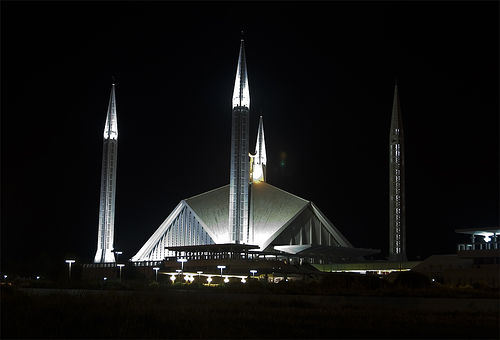

The Faisal Mosque in Islamabad is the largest mosque in Pakistan and South Asia and the sixth largest mosque in the world. It was the largest mosque in the world from 1986 to 1993 when overtaken in size by the completion of the Hassan II Mosque in Casablanca, Morocco. Subsequent expansions of the Masjid al-Haram (Grand Mosque) of Mecca and the Al-Masjid al-Nabawi (Prophet's Mosque) in Medina, Saudi Arabia during the 1990s relegated Faisal Mosque to fourth place in terms of size.

Faisal Mosque is the National Mosque of Pakistan. It has a covered area of 5,000 m2 (54,000 sq ft)[citation needed] and has a capacity to accommodate approximately 300,000 worshippers (100,000 in its main prayer hall, courtyard and porticoes and another 200,000 in its adjoining grounds). Although its covered main prayer hall is smaller than that of the Hassan II Mosque in Casablanca (the world's third largest mosque), Faisal Mosque has the third largest capacity of accommodating worshippers in its adjoining grounds after the Masjid al-Haram (Grand Mosque) of Mecca, the Al-Masjid al-Nabawi (Prophet's Mosque) in Medina.[1]. Each of the Mosque's four minarets are 80 m (260 ft) high (the tallest minarets in South Asia) and measure 10 x 10 m in circumference.
The Faisal Mosque is named after the late King Faisal bin Abdul Aziz of Saudi Arabia, who supported and financed the project.

Aerial from the Faisal Masjid dominating the Islamabad skyline. In the foreground a U.S Army Chinook helicopter delivering relief supplies to earthquake stricken Kashmir (2005).
Design
The Faisal Mosque is the work of famous Turkish architect, Vedat Dalokay who won the Agha Khan Architectural Award with this project. The mosque's relatively unusual design fuses contemporary lines with the more traditional look of an Arab Bedouin's tent, with its large triangular prayer hall and four minarets. However, unlike traditional masjid design, it lacks a dome. The minarets borrow their design from Turkish tradition and are thin and pencil like. The interior of this prayer hall holds a very large chandelier and its walls are decorated with mosaics and calligraphy by the famous Pakistani artist Sadequain. The mosaic pattern adorns the west wall, and has the kalimah writtern in early Kufic script, repeated in mirror image pattern.

The mosque's architecture is a departure from the long history of South Asian Islamic architecture. It is one of the most outstanding and modern Islamic architecture examples in the world.
These Information is Taken by Wikipedia an some other.

No comments:
Post a Comment